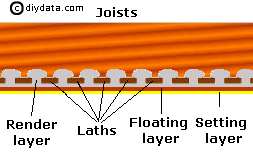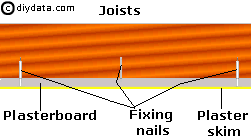Lath & plaster and Plasterboard ceilings
There are two basic forms for basic ceiling plaster surfaces:
When repairing a ceiling, the repair should ideally be carried out using the same materials as the original. Modern gypsum plasters are a lot harder and more brittle that the traditional lime putty used in older constructions.
Lath and plaster
 From the early eighteenth until the mid twentieth century, ceilings were usually made using lath and plaster techniques (see right).
From the early eighteenth until the mid twentieth century, ceilings were usually made using lath and plaster techniques (see right).
The laths are the strips of wood (usually about 25mm by 6mm (1 by 1/4 inch) nailed to the underside of timber joists with about 6mm (1/4 inch) gap between each lath.
The traditional method of coating lath and plaster ceilings was to apply three layers of lime putty mixture:
- The first layer (aka the render layer) was about 6mm (1/4 inch) thick and was forced through the gaps between the laths to achieve a strong bond to the laths.
- The second layer (aka the floating coating) was about 6mm (1/4 inch) thick and was applied to achieve a smooth surface for the thin, final layer.
- The third and final layer (aka the setting layer) was about 3mm (1/8 inch) thick and was smoothed off to give a suitable finish for decorating.
Traditionally the first and second layers were typically a 1:3 mixture of lime putty to clean, sharp sand; often animal hair was also mixed in to help it bind together. The third layer was typically either lime putty on its own or a 3:1 lime putty to fine sand mixture.
Towards the end of the nineteenth century the practice developed to add gypsum or cement to the mixtures to decrease the time delay between each layer. These mixes were typically 1:1:6 (gypsum/cement:lime putty:sharp sand) for the first two layers and equal parts gypsum and lime putty for the setting layer.
The use of lath and plaster was largely replaced by the use of pre-manufactured plasterboard when that became available in the mid twentieth century.
Plasterboard ceilings
 With the development of sheet plasterboard in the mid twentieth century, this largely replaced lath and plaster ceiling construction (see right).
With the development of sheet plasterboard in the mid twentieth century, this largely replaced lath and plaster ceiling construction (see right).
The sheets of plasterboard were simply cut to size, lifted into place under the joists and nailed to the joists. The joints between sheets were often just butted together and the whole surface skimmed with a setting plaster mixture - this, however, commonly lead to cracks in the ceilings along the edges of the plasterboard. Later the practice was introduced to apply 'scrim' (a fairly narrow (50mm (2 inches)) fine, flexible over-weave jute fabric or plastic tape) over the joints before the plaster skim was applied, this prevented the plaster skim from cracking along the joints.
Modern (21st century) practice is to screw the plasterboard to the joists and just seal the joints, the surface then being finished with a textured or plain flexible paint.
See also:
